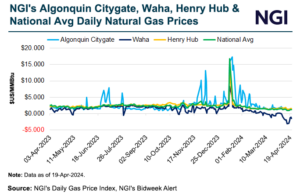Regulatory | Mexico | NGI All News Access
Texas Regulators Order Hardening of ‘Critical’ Natural Gas Infrastructure Following Winter Storm Uri
© 2024 Natural Gas Intelligence. All rights reserved.
ISSN © 2577-9877 | ISSN © 2577-9966 |

Markets
Natural gas futures struggled to find direction on Friday, trading in a narrow range of gains and losses throughout the session. Favorable near-term weather forecasts and continued light production estimates were countered by export weakness and only modest improvement in supply/demand balances evidenced in the latest government inventory data. At A Glance: Output near 98…
April 19, 2024Natural Gas Prices
By submitting my information, I agree to the Privacy Policy, Terms of Service and to receive offers and promotions from NGI.